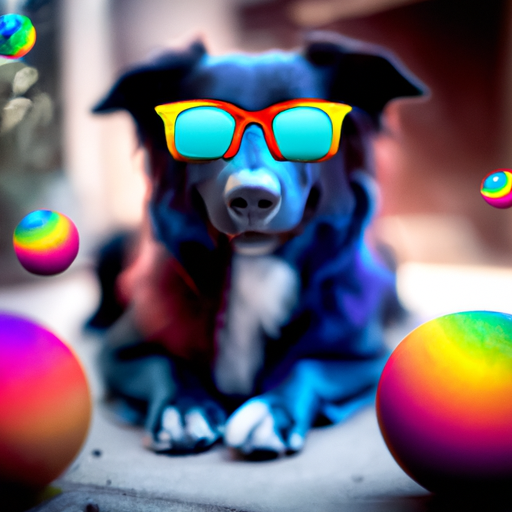Ever find yourself wondering, “What is a dog’s vision like?”. As a dog owner or lover, you might be curious to know how your furry friend perceives the world around them. How do they distinguish objects or comprehend colors? In this comprehensive guide, we will delve deep into the world of canine vision, backed by scientific research and expert insights.
Table of Contents
1. The Science Behind Dog Vision
2. Color Perception in Dogs
3. Visual Acuity and Field of View
4. Night Vision and Movement Detection
5. Factors Affecting Dog Vision
6. Frequently Asked Questions
Key Takeaways
* Dogs see the world differently than humans, primarily in shades of blue and yellow.
* Dogs’ visual acuity is not as sharp as humans, but they excel in detecting movement and have superior night vision.
* Factors like breed, age, and health can affect a dog’s vision.
The Science Behind Dog Vision
Let’s start by understanding the basic science behind dog vision. Dogs, like humans, perceive the world through their eyes, which are composed of rods and cones. Cones help in detecting colors while rods are responsible for low-light vision and motion detection. However, dogs have fewer cone cells than humans, leading to a different color perception. On the other hand, more rod cells make dogs superior at detecting movement and seeing in dim light.
Color Perception in Dogs
Contrary to popular belief, dogs do not see the world in black and white. According to a study by the University of California, Santa Barbara, dogs see colors, but not in the same way humans do. Their world is not a vibrant array of colors; instead, it is primarily composed of shades of blue and yellow. This is because dogs are dichromats, meaning they have two types of color receptors in their eyes, unlike humans who are trichromats and have three.
Here’s a simple table that illustrates the differences in color perception between dogs and humans.
| Human Color | Dog Equivalent |
|---|---|
| Red | Dark Gray |
| Green | Yellow |
| Blue | Light Blue |
| Yellow | Yellow |
Visual Acuity and Field of View
Visual acuity in dogs is less sharp compared to humans. If you’ve ever noticed your dog struggling to recognize you from a distance, that’s because of their lower visual resolution. While humans have 20/20 vision, dogs typically have 20/75 vision. This means that what humans can see clearly from 75 feet, dogs would need to be 20 feet away to see the same detail.
However, dogs have a wider field of view than humans. Depending on the breed and the positioning of their eyes, dogs can have a field of view between 240 to 270 degrees, compared to only 180 degrees for humans. This wider perspective helps dogs detect motion and threats in their peripheral vision, contributing to their survival instincts.
Night Vision and Movement Detection
One area where dogs unquestionably outperform humans is in night vision and motion detection. The higher proportion of rod cells in their eyes allows dogs to see better in low light conditions. Additionally, they have a special layer behind their retina, called the tapetum lucidum, which reflects light back through the retina, enhancing their night vision.
When it comes to detecting movement, dogs are experts. Whether it’s a squirrel scurrying up a tree or a car moving in the distance, dogs are likely to spot it before you do. This ability can be attributed to their evolutionary history as hunters, where spotting prey from a distance was crucial for survival.
Factors Affecting Dog Vision
Several factors can affect dog vision, including breed, age, and health. Some breeds, for instance, are predisposed to certain eye conditions that can affect vision. Age-related vision decline is also common in dogs, similar to humans. Regular vet check-ups can help detect and manage these conditions to ensure your dog’s vision remains as clear as possible.
For a deeper dive into dog health and vision care, check out these articles on dog eye health, caring for senior dogs, and understanding breed-specific health issues.
Frequently Asked Questions
1. Can dogs see in the dark?
Yes, dogs have superior night vision compared to humans thanks to the high number of rod cells in their eyes and the presence of the tapetum lucidum.
2. Do dogs see in color or black and white?
Dogs see in color, but not in the same way humans do. They are dichromats and see the world primarily in shades of blue and yellow.
3. How can I tell if my dog’s vision is deteriorating?
Changes in behavior such as clumsiness, reluctance to go out in the dark, or difficulty finding toys or food can indicate vision problems. Regular vet check-ups are essential in detecting and managing vision issues.
4. Can dogs watch TV?
Yes, dogs can watch TV, but they perceive the images differently. They are more likely to be attracted to the movement and sounds rather than the detailed images on the screen.
Understanding how your furry friend sees the world can help you cater to their needs better and enrich their environment. Remember, their vision plays a key role in their behavior and interaction with the world, just like ours does for us.



